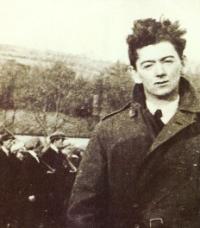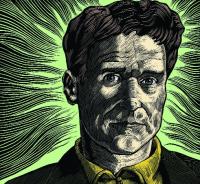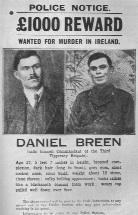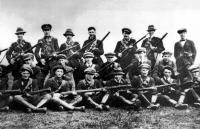TV eye:Bóthar na Saoirse Guerilla days in Ireland: Scéal Tom Barry My fight for Irish freedom: Scéal Dan Breen On another man’s wound: Scéal Ernie O’Malley Black Rock Pictures for TG4, autumn 2010 by John Gibney
Published in 20th-century / Contemporary History, Issue 6 (Nov/Dec 2010), Reviews, Revolutionary Period 1912-23, Volume 18
Tom Barry—son of an RIC officer who learned his military trade in the British Army in Mesopotamia.
The Irish revolution produced three memoirs that tower above all others, and each one lends its title to an episode of this useful and engaging series. Tom Barry was the son of an RIC officer who learned his trade in the British Army before deploying his skills in a rather different cause back home. Dan Breen came from a small farming background in Tipperary and joined the IRB as early as 1912. Ernie O’Malley came from a middle-class background in Mayo and eschewed his family’s support for constitutional politics in the aftermath of the Easter Rising. Diverse and fascinating characters who led diverse and fascinating lives, their common denominator lies in their ruthless commitment to physical-force republicanism, their opposition to the Treaty of 1921 and the fact that they recorded their experiences in ways that still provide, for many, the most vivid introductions to this revolution. Breen’s My fight for Irish freedom (1924) was ghostwritten to provide him with a much-needed income after the Civil War. O’Malley’s On another man’s wound (1936)—the only one of the three that, as the late John McGahern rightly pointed out, is truly a classic of Irish literature—was begun in far more bohemian settings in New Mexico. And Barry’s Guerilla days in Ireland (1949), detailing his activities at the head of the most famous of the flying columns, acquired fame as a virtual textbook on guerilla warfare, read around the world by insurgents and their enemies alike. Of the three, Barry has attracted the most attention in more recent times. And this brings us to the late Peter Hart.
![Peter Hart—grudgingly conceded the possibility that one of the men he interviewed [about Kilmichael] could have led him up the garden path.](https://www.historyireland.com/wp-content/uploads/2013/03/82_small_1290259263.jpg)
Peter Hart—grudgingly conceded the possibility that one of the men he interviewed [about Kilmichael] could have led him up the garden path.

Ernie O’Malley—according to John McGahern, his On another man’s wound is a classic of Irish literature. (Brian Gallagher)
It is a commonplace to draw a distinction between the conflicts of 1919–21 and 1969–94—or, more accurately, the supposed distinction is between the different manifestations of the IRA who fought in these periods. It is a comforting rhetorical strategy for some Irish nationalists, for if such a distinction can be drawn, then the thorny issue of moral or ethical equivalence can be sidestepped. But can it really be? For example, what if the more recent troubles had lasted only two and a half years? And what if the War of Independence had lasted 25? How would these conflicts have evolved? And how would we view them? It is an uncomfortable conundrum that lurks at the foundation of Irish independence. One of the interviewees here was Martin McGuinness, who understandably had no problem with drawing a continuity between the two eras. But attempts could be made to draw other continuities. Pro-unionist polemicists seized upon aspects of Peter Hart’s research to give legitimacy to strident and as yet unsubstantiated allegations of ‘ethnic cleansing’, for to characterise Irish republicanism as sectarian in the past was to cast it as sectarian in the present. But in this regard, present politics could get the better of history. For while Hart, a Canadian, had indeed suggested that the concept had a relevance to Ireland, this was not a point that he himself continued to press; quite the opposite. Hart was far more fair-minded than some of his critics allowed, and had bemoaned, with good reason, how Kilmichael and Dunmanway overshadowed the rest of what he had written. In his later work, namely The IRA at war (2003), he seems to have moved away from some of the more eye-catching assertions made in his earlier career to arrive at more nuanced conclusions about the nature of the Irish revolution, and most especially the role of ethnicity and sectarianism within that revolution. It would have been interesting to see how his thought developed. His flawed but impressive body of work remains of great importance to the study of that revolution. But the fact remains that very serious methodological criticisms were levelled at key aspects of Hart’s research into the Cork IRA, and he never satisfactorily answered them in his lifetime; they will continue to cast a shadow over his work.

Dan Breen—from a small farming background in Tipperary.
Why concentrate on Hart? Because there are wider issues at stake. The Irish revolution, perhaps because of its uncomfortable resonance, remains contentious. It is the role of its historians to make sense of it, for there is much about it we have yet to learn. These three documentaries provide a fascinating and quite even-handed introduction to the events of 1916–23 (though it is a pity that the reconstructions proved disappointing). The programmes did not shy away from the complexities of the period, and an impressive array of talking heads were on hand to flesh out the three stories that were told. But, significant as they are, they are only three stories; there are many more to be revealed. In the meantime, the memoirs of Barry, Breen and O’Malley remain essential reading, in which case documentaries such as these should become essential viewing. HI

An IRA flying column in Tipperary. What if the War of Independence had lasted 25 years?
















